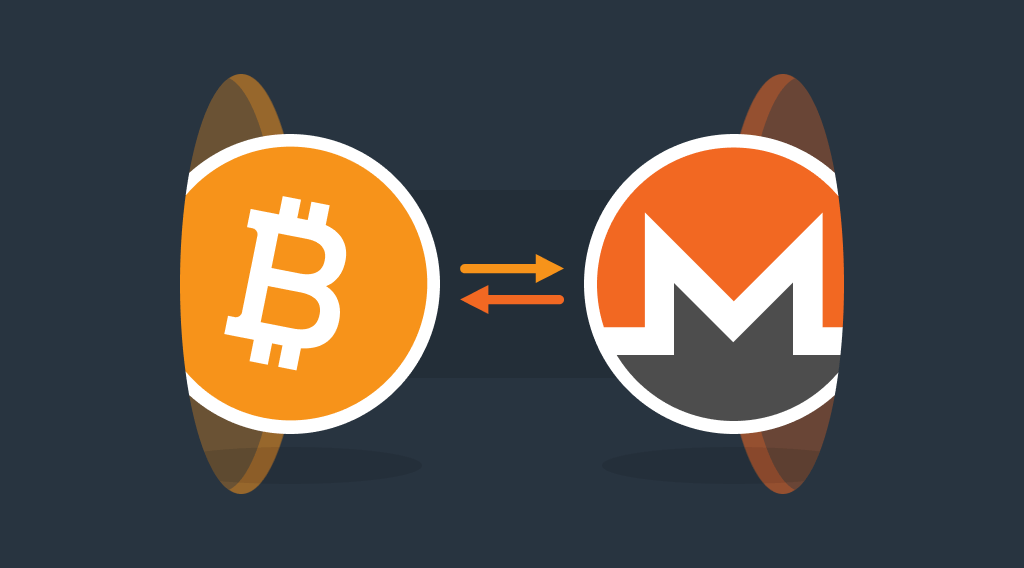Exchange XMR to BTC with the Lowest Fees
In the dynamic world of cryptocurrencies, transferring or swapping between different coins can be a necessity for traders. With an ever-expanding ecosystem of tokens and coins, finding an efficient and low-fee way to make these exchanges is critical. Among these popular trades is the XMR to BTC exchange, and this guide is tailored to help you navigate this process with the lowest costs possible.
Buy Bitcoin (BTC) for Monero (XMR)
For many, the decentralized nature of Monero provides unparalleled privacy and security. However, there are times when you might need to pivot towards the more universally recognized Bitcoin. Whether it’s for an online transaction that only accepts Bitcoin or simply a strategic move to diversify your portfolio, as well as swap XMR to BTC is a straightforward process.
When selecting a platform to perform this exchange, it’s imperative to consider the following:
- Transparency: Ensure that the platform you select provides clear fee structures, so you aren’t caught off guard by hidden charges.
- Security: With increasing incidents of crypto hacks, ensure the platform uses state-of-the-art security measures.
- Reputation: Sometimes the community’s voice is the best indicator. Opt for platforms with strong reviews and an established reputation.
Exchange Your Crypto Now
While the crypto market never sleeps, there’s no time like the present to make your move. Prices are constantly fluctuating, driven by a host of market dynamics. The sooner you can familiarize yourself with the exchange process, the quicker you can take advantage of market conditions that suit your financial strategies.
To initiate an exchange:
- Log in to your platform of choice.
- Navigate to the exchange or swap section.
- Select ‘XMR’ as your source currency and ‘BTC’ as your target currency.
- Input the amount you wish to exchange.
- Review the transaction details, ensuring you’re comfortable with the fees and exchange rate.
- Confirm the transaction. In a matter of minutes, your BTC should appear in your respective wallet.
How XMR to BTC Exchange Works
For the uninitiated, the process of exchanging one cryptocurrency for another might seem a tad overwhelming. However, at its core, it’s relatively simple. The process, in essence, involves selling your XMR tokens at the current market rate to buy BTC.
Here’s a simplified breakdown:
- Platforms maintain a liquidity pool or have access to liquidity from various sources to ensure seamless exchanges.
- The exchange rate is determined by the current market value. Rates can be fixed (for a specific time frame) or variable (changing with the market).
- Once you initiate the transaction, the platform will match your order with a counter-order, effectively selling your XMR and buying BTC on your behalf.
- The BTC is then transferred to your designated wallet, and the XMR is subtracted from your account.
Live BTC Price (in XMR)
Before executing any trade, it’s prudent to be aware of the current exchange rate. Platforms often offer real-time price tracking, showing the live BTC price in terms of XMR. This information is invaluable as it:
- Informs your trade: Knowing the exact amount of BTC you’ll receive for your XMR ensures you make an informed decision.
- Helps in strategizing: If you’re looking to maximize your returns, tracking these prices can help you identify patterns or trends that could be beneficial for your trades.
Many top platforms offer charting tools, historical data, and even prediction models to aid in this process.
Monero to Bitcoin Exchange Video Guide
For visual learners or those who prefer a more interactive form of guidance, several video tutorials walk you through the entire process of converting XMR to BTC. These video guides are particularly helpful because they:
- Demonstrate the process in real-time: This removes ambiguity and provides a clear picture of what to expect.
- Highlight platform-specific features: Each platform might have unique features or steps. Video guides tailored to specific platforms can provide clarity.
- Offer tips and tricks: Often, these videos provide insights into maximizing returns, minimizing fees, or even troubleshooting common issues.
To find a comprehensive video guide, a quick search on popular video-sharing platforms or the chosen exchange’s website usually yields valuable results.
With the above insights, your journey from Monero to Bitcoin should be smoother, more informed, and, most importantly, cost-effective. Whether you’re a seasoned trader or just dipping your toes into the crypto waters, understanding the mechanics of such exchanges will undoubtedly stand you in good stead as the digital economy continues to evolve.
Monero to Bitcoin Price Chart
When diving into the world of cryptocurrency trading and investments, visuals can be remarkably insightful. The Monero to Bitcoin price chart provides a graphical representation of the exchange rate dynamics between these two cryptocurrencies over time. Depending on the tool or platform you’re using, you can adjust this chart to display data on various timelines: daily, weekly, monthly, or even yearly.
A few significant advantages of utilizing a price chart include:
- Historical Analysis: Easily discern how the value of Monero has compared to Bitcoin historically.
- Pattern Recognition: Active traders often use charts to recognize patterns, which can suggest potential future price movements.
- Trading Volume: Many charts also showcase trading volume, allowing users to see the quantity of trades made within a specific time frame. High volume periods can indicate heightened interest or significant market events.
Monero Vs. Bitcoin Currency Compare
Distinguishing the unique features and benefits of Monero (XMR) and Bitcoin (BTC) can provide a clearer understanding of each cryptocurrency’s value proposition:
Monero (XMR)
- Privacy-Centric: Monero’s primary claim to fame is its emphasis on privacy. Transactions are untraceable, making it a favorite for users valuing discretion.
- Dynamic Scalability: Unlike Bitcoin, Monero doesn’t have a pre-set block size limit. This can lead to more flexibility in transaction times.
- Fungibility: Due to its privacy features, each Monero coin remains interchangeable and indistinguishable from others.
Bitcoin (BTC)
- First Mover Advantage: As the first cryptocurrency, Bitcoin enjoys widespread recognition and acceptance.
- Store of Value: Often referred to as ‘digital gold’, many view Bitcoin as a hedge against economic instability.
- Decentralization and Security: With a vast and robust network, Bitcoin’s decentralized nature makes it highly secure against attacks.
While both cryptocurrencies have their advantages, your preference will largely depend on your values, such as whether you prioritize privacy or widespread acceptance.
Price Calculator
For those looking to exchange Monero for Bitcoin or vice versa, a price calculator is an invaluable tool. By simply entering the amount of one cryptocurrency, the calculator instantly provides its equivalent value in the other. This not only ensures that you’re getting a fair deal but also simplifies the process for newcomers to the crypto scene.
Moreover, many price calculators often come equipped with:
- Real-time rate updates: This provides users with the most accurate exchange value at any given time.
- Historical data: Checking past rates can offer insight into current market conditions.
Purchase Crypto from Your Monero Wallet
A notable feature available to many Monero wallet users is the ability to directly purchase other cryptocurrencies, including Bitcoin. This capability streamlines the process, eliminating the need for third-party platforms or exchanges. Here’s how you can typically go about it:
- Access your Monero wallet.
- Navigate to the ‘Exchange’ or ‘Purchase’ section within the wallet interface.
- Select Bitcoin (or any other crypto) as your desired purchase.
- Enter the amount of Monero you’d like to spend or the amount of Bitcoin you’d like to receive.
- Confirm the transaction details and finalize the purchase.
This direct method is not only more convenient but often incurs fewer fees than using external platforms.
XMR to BTC Exchange Rate
The exchange rate between Monero and Bitcoin is a crucial metric, especially for traders or those looking to swap their holdings. This rate is primarily influenced by supply and demand dynamics in the market but can also be impacted by broader economic factors, news, regulatory developments, or technological advancements related to either cryptocurrency.
It’s advisable to keep an eye on various crypto news sources and perhaps even set up rate alerts to stay informed about any significant shifts in the XMR to BTC exchange rate.
XMR to BTC Price Details
When examining the price details between XMR and BTC, it’s crucial to delve beyond just the headline rate. Several factors can provide a more holistic view of the exchange landscape:
- Spread: The difference between the buying and selling price can impact the cost of your transaction.
- Liquidity: A higher liquidity often suggests more stability in the given exchange rate.
- Transaction Fees: Many platforms charge a fee for the exchange, which can vary widely. Ensure you’re aware of these to avoid unexpected costs.
- Historical Performance: While past performance isn’t always indicative of future results, understanding historical price relationships can offer context.
By taking these factors into account, you can ensure a more informed and strategic approach to your XMR to BTC exchanges.
Top Crypto Exchanges Without KYC
The rise of cryptocurrency has also led to a proliferation of exchanges, some of which mandate a Know Your Customer (KYC) process. KYC involves verifying the identity of users before allowing them to engage in financial transactions. However, not all users are comfortable sharing personal information, which has led to the popularity of non-KYC platforms. Here are a few of the top crypto exchanges that operate without a KYC requirement:
- Changelly: Renowned for its intuitive interface and efficient swap system, Changelly allows for seamless cryptocurrency exchanges without extensive identity verification processes.
- Shapeshift: This platform permits users to swap between cryptocurrencies anonymously, ensuring that user privacy remains uncompromised.
- KuCoin: While it offers certain advanced features that require KYC, KuCoin allows basic trading functionalities without the need for full identity verification.
- TradeOgre: Popular among niche crypto communities, TradeOgre provides a straightforward, no-frills trading platform where KYC isn’t necessary.
- Bisq: As a decentralized exchange, Bisq lets users trade directly with each other in a peer-to-peer manner, negating the need for KYC entirely.
It’s essential to exercise caution and conduct thorough research when using non-KYC platforms, ensuring that security and privacy aren’t compromised.
Choose the Crypto Exchange Pair
Before executing a transaction, it’s crucial to specify the pair of cryptocurrencies you intend to exchange. In the context of this article, our focus is on the Monero (XMR) to Bitcoin (BTC) pairing, but many exchanges offer hundreds of possible combinations.
To choose the correct pair:
- Navigate to the Exchange Platform: Log into your chosen platform, and head to the trading or exchange section.
- Search or Scroll: Use the search bar to directly enter your desired pairing (like XMR/BTC) or scroll through the list of available pairs until you find the one you’re looking for.
- Set the Amount: Once the pair is selected, input the amount of the source cryptocurrency you wish to exchange.
- Review Rates: Always check the current exchange rate, fees, and any other relevant details before confirming the transaction.
Choosing the correct exchange pair is fundamental to ensuring you receive the desired cryptocurrency in return.
Frequently Asked Questions
How much is 1 Monero worth in Bitcoin?
The value of 1 Monero in Bitcoin can fluctuate based on a host of factors including market demand, overall cryptocurrency market health, technological advancements, and news concerning either coin. For real-time exchange rates, it’s recommended to consult live price charts on crypto exchanges or financial data platforms. Many sites also offer historical data, allowing users to track the price movement of Monero against Bitcoin over time.
How to swap Monero to Bitcoin?
Swapping Monero to Bitcoin is a straightforward process:
- Choose an Exchange: Select a reputable cryptocurrency exchange platform that supports the XMR to BTC pairing.
- Create or Log Into Your Account: New users might need to set up an account, while returning users can simply log in.
- Navigate to the Exchange Section: Locate the section dedicated to currency swaps or trading.
- Select the XMR to BTC Pair: Once located, specify the amount of Monero you wish to swap.
- Review and Confirm: Before confirming, check the exchange rate and any associated fees. Once satisfied, finalize the transaction.
- Receive Bitcoin: After the exchange is processed, Bitcoin will be credited to your wallet on the exchange or to another specified wallet address.
How to swap XMR to BTC
The process of swapping XMR to BTC mirrors that of the Monero to Bitcoin transaction. Here’s a quick step-by-step:
- Platform Selection: Opt for a platform that offers XMR to BTC trades. Ensure it’s secure and trustworthy.
- Account Access: If you’re a new user, register. Returning users can enter their credentials to access their accounts.
- Find the Trading Section: Within the platform’s interface, locate the area designated for cryptocurrency trades or swaps.
- Initiate the Swap: In the trading section, input the amount of XMR you wish to exchange for BTC. The system will display how much BTC you’ll receive based on the current exchange rate.
- Review Details: Ensure you’re comfortable with the exchange rate, fees, and other transaction specifics.
- Execute the Swap: Once you’re ready, confirm the swap. Shortly after, the corresponding amount of BTC will appear in your designated wallet.
Regardless of the platform or the specific terminologies used, the core process remains similar across exchanges. Always prioritize security and transparency when executing any trades.
Why convert Monero to Bitcoin?
Converting Monero to Bitcoin can be influenced by several reasons:
- Liquidity and Acceptance: Bitcoin, being the pioneer cryptocurrency, boasts a wider acceptance across merchants and platforms globally. Converting Monero to Bitcoin might be a strategic move for those who intend to spend or invest their cryptocurrency in platforms or regions where BTC is more widely accepted.
- Diversification: As with traditional investment strategies, diversifying one’s crypto holdings can minimize risks. By converting some Monero to Bitcoin, investors can balance their portfolios and guard against market volatility specific to one coin.
- Speculative Motives: Traders might believe that Bitcoin will appreciate faster or is currently undervalued compared to Monero. In such cases, converting Monero to Bitcoin can be a tactical move aiming at potential profits.
Are there limits for exchanging XMR and BTC?
On many platforms, there are limits imposed on the amount of cryptocurrency one can exchange, especially for new or unverified users. These limits can be set on a daily, weekly, or monthly basis. Factors influencing these limits include:
- Platform’s Policy: Some exchanges impose limits to mitigate risks associated with large transactions.
- User Verification Level: Higher limits are often given to users who’ve completed more extensive verification processes, like KYC.
- Transaction Type: Withdrawal, deposit, and trading might have different limits.
Always check the specific limits on your chosen exchange platform before executing a transaction.
Can I exchange my crypto without KYC?
Yes, several cryptocurrency exchanges allow users to trade without undergoing a KYC (Know Your Customer) process. However, trading without KYC might come with certain restrictions, such as:
- Lower Limits: Non-KYC users might have lower deposit, withdrawal, or trading limits.
- Reduced Functionality: Some advanced trading features might be reserved for verified users.
It’s essential to prioritize security when choosing non-KYC platforms. While they offer more privacy, they might sometimes be more vulnerable or less regulated.
How can I find the lowest fee crypto exchange to swap XMR and BTC?
Finding the lowest fee exchange requires a bit of research:
- Comparison Websites: Websites like CryptoCompare or CoinGecko provide detailed insights into various exchanges, including their fee structures.
- User Reviews: Platforms like Reddit, Twitter, or specialized crypto forums can be valuable sources of user-generated insights regarding fees.
- Official Exchange Websites: Always check the official fee schedule of your chosen platform.
Remember, while fees are important, they shouldn’t be the sole deciding factor. Security, user experience, and platform reliability are equally vital.
Instead of exchanging, can I buy BTC? If so, how to buy cryptocurrency?
Absolutely, purchasing BTC directly is an option:
- Choose a Platform: Decide whether you prefer a traditional exchange, peer-to-peer platform, or cryptocurrency brokerage.
- Sign Up: Create an account, providing the necessary details.
- Verify Account: Some platforms might require ID verification, especially if dealing with significant amounts or fiat transactions.
- Deposit Funds: Transfer fiat currency (like USD, EUR, etc.) to your account using bank transfers, credit cards, or other payment methods.
- Buy BTC: Navigate to the trading section, select the BTC/fiat pair, specify the amount you want to buy, review the price and fees, and confirm the purchase.
- Secure Storage: It’s recommended to transfer your BTC from the exchange to a secure personal wallet, especially if it’s a significant amount.
Is there a way to predict cryptocurrency prices – for example, for XMR and BTC?
Predicting cryptocurrency prices is complex and involves various methodologies:
- Technical Analysis (TA): TA involves studying price charts and using statistical measures to predict future price movements. It’s based on the principle that historical price movements can indicate future trends.
- Fundamental Analysis: This entails examining the intrinsic value of a cryptocurrency. For BTC, it might involve studying adoption rates, regulatory news, technological advancements, or market sentiment.
- Sentiment Analysis: This method gauges the mood of market participants, usually by analyzing news articles, tweets, and forum posts.
- Economic Models: Some experts use models like stock-to-flow to predict BTC’s price, correlating it with scarcity.
- External Factors: Macro events, such as geopolitical situations or financial crises, can also influence prices.
However, it’s essential to understand that, given the volatile nature of the cryptocurrency market, predictions should be approached with caution. Always do thorough research and consider consulting with financial advisors.



